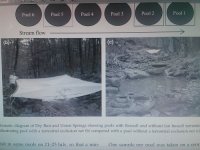whoops I had been looking at this article on a system that linked thru to the entire report. I'll take the liberty of copying a snip from the conclusion describing the diet of brookies isolated in pools by low flow conditions of intermittent streams:
"In our study, benthic resources were already the most
abundant source of invertebrates, but despite this, aquatic
invertebrates did not comprise an equally large part
of brook trout diets. This is surprising because if aquatic
invertebrates were accessible, brook trout in intermittent
streams should be more likely to switch to this resource
because fish were confined to isolated pools and could
not migrate to areas with greater terrestrial inputs as
seen with native charr in perennial streams (Kawaguchi
et al., 2003). We suspect that the majority of benthic
invertebrates in our study area were largely unavailable
as prey because of their smaller size and hiding potential." ...
"Brook trout also may have restricted foraging on
aquatic invertebrates because of competition with sculpin,
which feed solely from the benthos. Brook trout
and sculpin may not compete for food resources in
perennial streams (Cheever & Simon, 2009), but this
could change when flows are reduced and brook trout
can no longer feed on the drift."
reinforces the importance of terrestrials to brookies even when isolated in pools by low flows..




